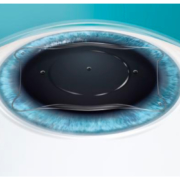LASIK For Astigmatism: Can I Get LASIK with Astigmatism?
Medically Reviewed by Dr. Anthony Nappi / Published October 20, 2022 / 4 min. read

Astigmatism is a type of refractive error not unlike myopia (nearsightedness) and hyperopia (farsightedness). The most common form is corneal astigmatism, which occurs when the shape of your cornea is uneven. Instead of a sphere, it has more of a “football” shape. It alters the way your eyes bend light, creating blurry vision.
If you have astigmatism, with or without other vision issues, you may have wondered if you can get LASIK. Here’s what you need to know.
LASIK is Possible with Astigmatism
In many cases, LASIK is possible if you have astigmatism. However, you must be a candidate for the procedure in general before you can undergo treatment and meet the astigmatism surgery age of at least 18.
It’s important to know that LASIK is only possible for certain types of astigmatism. How does laser eye surgery correct your vision? The procedure itself involves reshaping the cornea. As such, it can only address corneal astigmatism. LASIK won’t be able to address lenticular astigmatism or a misshapen lens.
Generally, LASIK is also only possible if you have the regular subtype of astigmatism. The irregular subtype, which is often the result of trauma or certain eye conditions affecting the cornea, is more difficult to treat with laser eye surgery.
Can I Get LASIK If You Have High Astigmatism?
Vision experts measure refractive errors, including astigmatism, in diopters:
- Mild astigmatism: Less than 1.00 diopters
- Moderate astigmatism: 1.00 to 2.00 diopters
- High astigmatism: 2.00 to 4.00 diopters
- Extreme astigmatism: Greater than 4.00 diopters
Although high astigmatism is a more severe form, you may still be able to undergo LASIK. Even those with astigmatism measuring greater than 4.00 diopters can still qualify, depending on the severity of their situation. The procedure may not fully correct your vision, but you’re likely to notice a drastic improvement.
What Is the LASIK Astigmatism Limit?
While LASIK can help correct your vision if you have higher levels of astigmatism, there are limits. Your correction must measure 6.00 or fewer diopters to qualify. If your astigmatism is too severe, LASIK may not be the right treatment for you, even if you meet all other requirements.
How Successful Is LASIK for Astigmatism?
LASIK can be a highly effective solution for correcting astigmatism. While individual results may vary, many people with mild to moderate astigmatism achieve 20/20 or better vision and no longer need to wear glasses or contacts.
Even people with higher levels of astigmatism can experience dramatic improvements in their vision following LASIK. Depending on the severity of your astigmatism, you may need more than one treatment to achieve the best results, though. You should also know that, even after laser vision correction, you may still need to wear glasses or contacts to see clearly. However, your prescription requirements are likely to be much lower.
Is Laser Eye Surgery for Astigmatism Permanent?
LASIK involves using a laser to permanently change the shape of your corneas, altering the way your eyes bend light. While some patients require an enhancement to improve their vision issues further, including astigmatism, Lasik provides a lasting solution.
Can Astigmatism Come Back After LASIK?
Studies show that most patients still have 20/20 (or better) vision five years after LASIK. Following treatment, your vision shouldn’t worsen unless you develop cataracts later in life. However, if you had high levels of astigmatism or a strong prescription before LASIK, your vision issues can sometimes return. It’s rare for this to happen, though.
What Is the Cost of LASIK for Astigmatism?
The cost of LASIK varies based on several factors, including your prescription strength and your level of astigmatism. Other aspects that can influence your cost include the laser technology used, your surgeon’s experience, and any insurance or other financial incentives you may be eligible to use.
While the average price of LASIK ranges from $2,000 to $4,000, you can get a better idea of your actual laser eye surgery for astigmatism cost with a consultation. Additionally, keep in mind that although the price may seem expensive, the procedure can save you a lot of money in eye care costs over time.
What Is the Best Eye Surgery for Astigmatism?
LASIK may be the best-known eye surgery for vision issues, but it isn’t your only option. If you’re ineligible for LASIK, you may be eligible for PRK or ICL.
Photorefractive Keratectomy (PRK)
Photorefractive keratectomy is a laser eye surgery that involves removing the layer of skin over your cornea completely rather than creating a flap. A temporary lens goes over the eye to protect it while it heals. If you have thin corneas or a strong prescription, your surgeon may recommend PRK over LASIK.
Refractive Lens Exchange (RLE)
A refractive lens exchange procedure is similar to cataract surgery. It involves replacing the natural lens in your eye with an artificial one. The replacement lenses can address mild to moderate astigmatism.
Implantable Collamer® Lenses (ICL)
Another option to consider is Implantable Collamer® Lenses or Evo Visian ICL. With this procedure, your surgeon creates an opening in your cornea and positions the lenses underneath. Unlike LASIK and PRK, the procedure doesn’t involve removing any corneal tissue. It’s ideal for patients with dry eyes or thin corneas. However, it can’t correct hyperopia or astigmatism measuring greater than 4.00 diopters.
What Are the Pros and Cons of Laser Eye Surgery for Astigmatism?
Before undergoing any form of astigmatism surgery, you should weigh the pros and cons of the procedure to make sure it’s the best choice for you:
Pros
- Quick and safe outpatient procedure: Laser eye surgery procedures typically take 30 minutes or less for both eyes, and you can go home to rest afterward.
- Improved vision: Most patients can achieve 20/20 (or better) vision, even with astigmatism, and no longer need to wear glasses or contacts.
- Results don’t take long to notice: Many people note improvements in their vision within a month (although it can take three to six months for your vision to fully stabilize).
- Short-lived post-surgical side effects: It’s not uncommon to experience mild discomfort immediately following laser eye surgery, including itchiness, burning, and light sensitivity. Side effects are typically mild and clear up within a few days.
Cons
- Some risks exist: There are some risks involved with laser eye surgery, including prolonged dry eyes, impaired night vision, and halos. Although rare, infections and surgical complications are possible as well.
- Surgery may not provide 20/20 vision: While you may notice significant improvements in your vision if you have severe astigmatism, you may still need corrective lenses.
- Insurance doesn’t cover laser eye surgery: Insurance companies consider LASIK and PRK elective procedures and, therefore, don’t typically cover the cost. Even so, you should still check with your provider, as some may offer benefits that can reduce your out-of-pocket expenses.
Do You Have Astigmatism? Find Out If Laser Eye Surgery Is Right for You
Are you ready to find out if LASIK can eliminate (or reduce the severity of) your astigmatism? At BDP LASIK, our experienced laser eye surgeons can help determine if you’re a candidate, understand the benefits and risks of the procedure, and, if necessary, discuss your alternatives. Contact us to schedule your free LASIK consultation today!








 iStock
iStock